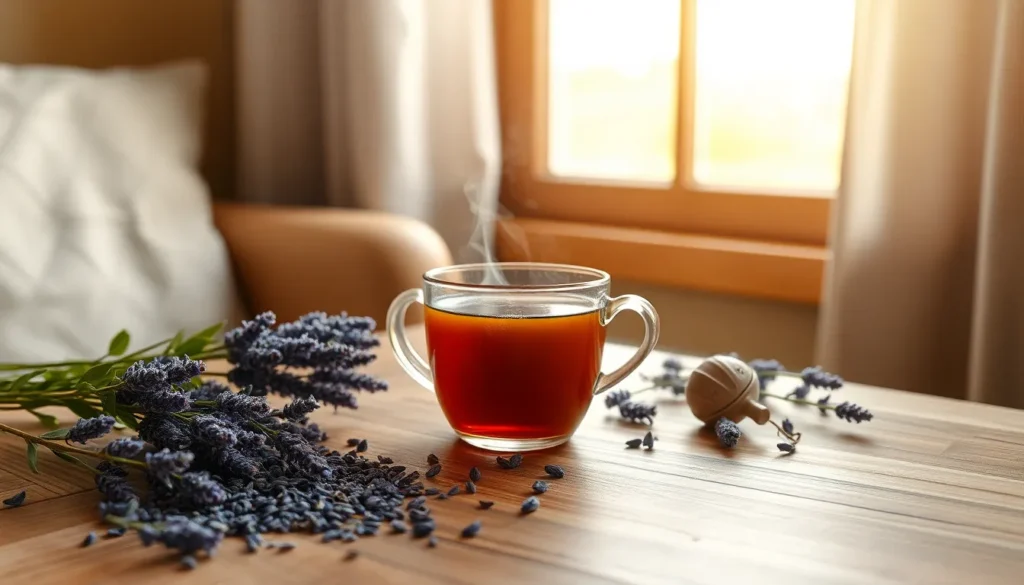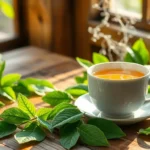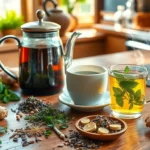We’ve all heard about lavender’s incredible relaxing properties, but did you know this fragrant purple flower makes one of the most beneficial teas you can sip? Lavender tea isn’t just a delightfully aromatic beverage – it’s a powerhouse of wellness benefits that have been treasured for centuries.
From ancient Roman baths to modern aromatherapy sessions, lavender has earned its reputation as nature’s ultimate stress reliever. When we brew those delicate buds into tea, we unlock a treasure trove of compounds that can transform our daily wellness routine. The gentle floral notes deliver more than just flavor – they carry potent antioxidants and calming properties that our bodies crave.
Whether you’re struggling with restless nights, daily stress, or simply want to add a luxurious moment of calm to your day, lavender tea offers a natural solution that’s both effective and enjoyable. Let’s explore why this purple powerhouse deserves a permanent spot in your tea collection.
What Is Lavender Tea
Lavender tea is an herbal infusion made from the dried flowers and buds of the Lavandula plant. We brew this fragrant tea by steeping lavender flowers in hot water, creating a soothing beverage with a distinctive floral aroma and gentle taste.
The tea comes primarily from two main varieties of lavender plants. English lavender (Lavandula angustifolia) produces the most commonly used flowers for tea preparation. French lavender (Lavandula stoechas) offers a slightly different flavor profile with more intense aromatic compounds.
Unlike traditional teas derived from the Camellia sinensis plant, lavender tea contains no caffeine naturally. We classify it as a tisane or herbal tea, making it perfect for evening consumption without disrupting sleep patterns.
The preparation process involves harvesting lavender flowers at peak bloom when essential oils reach their highest concentration. Producers then dry the flowers carefully to preserve their therapeutic compounds and delicate flavor. We can purchase lavender tea as loose dried flowers, pre-packaged tea bags, or blended with other complementary herbs.
Lavender tea delivers a mild, sweet flavor with subtle honey-like notes and a distinctive floral finish. The aroma releases calming properties even before we take our first sip, captivating our senses through both taste and smell.
This herbal beverage has gained popularity among wellness enthusiasts seeking natural alternatives to conventional teas. We find lavender tea particularly appealing because it combines the ritual of tea drinking with the therapeutic benefits of aromatherapy in a single cup.
Health Benefits of Lavender Tea
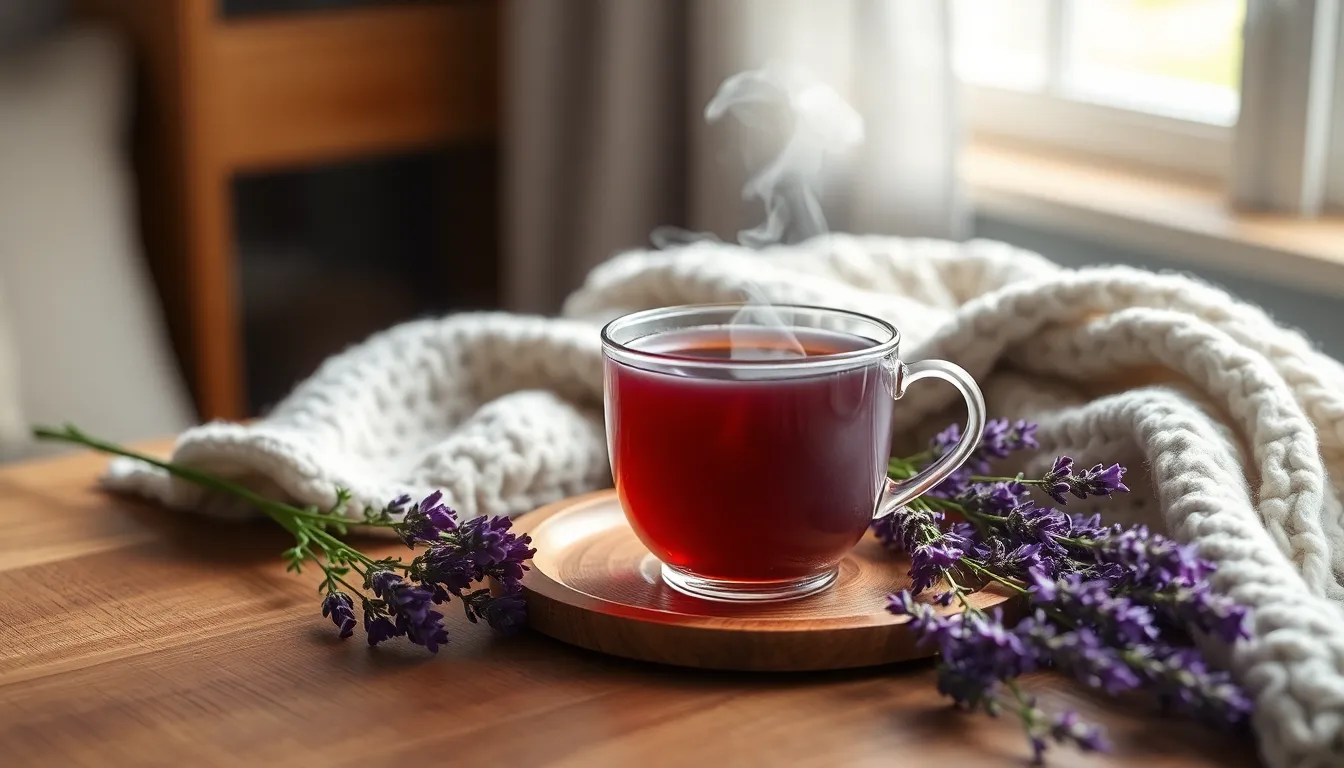
Lavender tea offers remarkable therapeutic benefits that extend far beyond its delightful aroma and taste. We’ll explore the scientifically backed health advantages that make this herbal infusion a powerful addition to your wellness routine.
Promotes Better Sleep and Relaxation
We find that lavender tea excels at improving sleep quality through its natural calming compounds. Studies demonstrate that lavender may increase deep slow-wave sleep, which represents the most restorative phase of our sleep cycle. This herbal tea works by lowering cortisol levels in our bodies, effectively reducing stress hormones that can interfere with peaceful rest.
The aroma and active ingredients in lavender tea calm brain function and soothe our nervous system. Sleep-deprived individuals particularly benefit from incorporating this tea into their nighttime routine. Regular consumption helps establish better sleep patterns while promoting deeper, more refreshing rest periods.
Reduces Anxiety and Stress
Clinical research reveals important anxiety reduction benefits from drinking lavender tea regularly. Studies show measurable decreases in both anxiety and depression scores among individuals who consume lavender herbal tea consistently. These findings highlight lavender’s effectiveness as a natural mood stabilizer.
We observe that oral lavender oil products demonstrate similar benefits for mood regulation and emotional balance. The tea’s compounds work directly on our nervous system to create feelings of calm and relaxation. Stress levels decrease noticeably when we incorporate lavender tea into our daily wellness practices.
Supports Digestive Health
Lavender tea provides gentle relief for various digestive concerns through its soothing properties. The tea helps relax our digestive tract muscles, reducing cramping and general discomfort after meals. Anti-inflammatory compounds within lavender work to ease symptoms associated with indigestion and uncomfortable bloating.
We appreciate how this herbal remedy addresses digestive issues without harsh side effects. The tea’s muscle-relaxing properties extend throughout our digestive system, promoting smoother digestion processes. Regular consumption may help establish more comfortable digestive patterns over time.
Anti-Inflammatory Properties
The anti-inflammatory compounds in lavender tea help reduce inflammation throughout our bodies. These properties benefit muscle and joint pain by targeting inflammatory responses at their source. We see particular advantages for cardiovascular health, as reduced inflammation helps prevent blood clots in inflamed arterial pathways.
Chronic inflammation contributes to many health issues, making lavender tea’s anti-inflammatory effects particularly valuable. The tea’s compounds work systemically to lower inflammatory markers in our bloodstream. Heart health receives additional support through improved circulation and reduced arterial inflammation.
Skin Health Benefits
Lavender tea contains antibacterial and antifungal properties that protect our skin from various infections. These natural compounds help reduce skin inflammation while fighting harmful microorganisms that can cause breakouts or irritation. Essential nutrients including vitamin C, calcium, and magnesium further enhance skin health and boost immune function.
We notice that regular lavender tea consumption supports overall skin appearance and texture. The tea’s antioxidant properties help combat free radical damage that contributes to premature aging. Internal consumption provides systemic benefits that complement topical skincare routines for comprehensive skin health support.
Types of Lavender for Tea
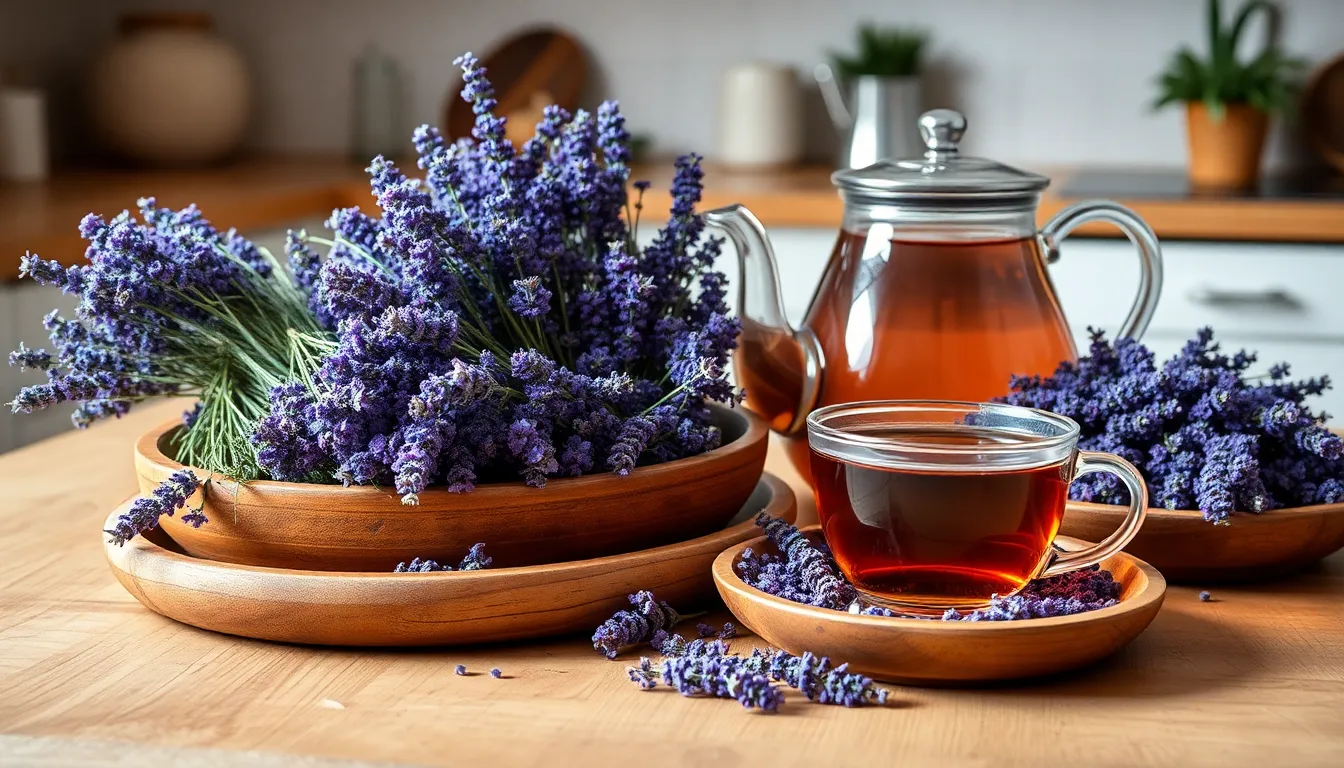
When selecting lavender for tea brewing, choosing the right variety makes a important difference in flavor and therapeutic benefits. Different lavender species offer unique characteristics that affect both taste and wellness properties.
English Lavender
English Lavender (Lavandula Angustifolia) stands as the gold standard for tea preparation due to its delicate flavor profile and superior consumption qualities. We recommend this variety as the best type for regular tea drinking because it delivers a mild sweetness without overwhelming floral intensity. The buds contain optimal levels of beneficial compounds while maintaining a pleasant taste that appeals to both new and experienced lavender tea drinkers. English Lavender produces a smooth infusion with subtle notes that complement rather than dominate the tea experience. Its gentle nature makes it perfect for daily consumption and blends well with other herbs when creating custom tea mixtures.
French Lavender
French Lavender (Lavandula Stoechas) offers a more robust alternative for those seeking stronger herbal properties in their tea. While not as frequently used for tea as English lavender, this variety provides intense aromatic qualities that some tea enthusiasts prefer. We find that French Lavender delivers a more pronounced flavor that works well in smaller quantities or when mixed with milder herbs. The stronger profile makes it particularly suitable for therapeutic applications where maximum herbal potency is desired. But, beginners should start with smaller amounts to assess their tolerance for its more assertive taste.
Choosing Quality Dried Lavender
Selecting premium dried lavender ensures optimal flavor and health benefits in every cup we brew. Organic and chemical-free lavender protects us from pesticides and harmful substances that could compromise both taste and wellness benefits. Fresh or dried lavender buds provide the best flavor intensity and therapeutic properties compared to older or processed alternatives. We recommend using approximately two tablespoons of dried lavender buds for an 8oz cup of tea to achieve the perfect balance of flavor and potency. Quality lavender should display vibrant color, strong natural fragrance, and intact bud structure that indicates proper harvesting and drying methods.
Ingredients
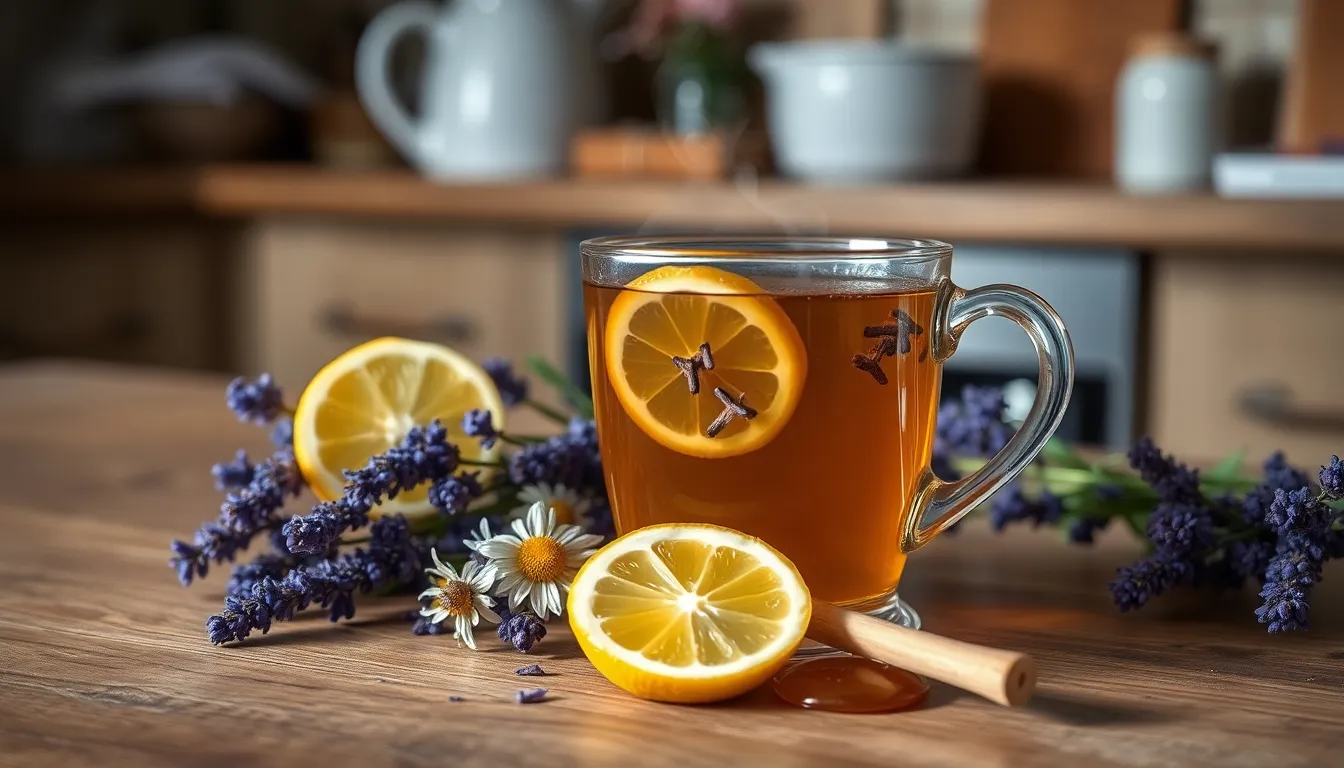
Creating the perfect cup of lavender tea requires just a few simple yet carefully selected ingredients. We recommend using high-quality components to maximize both the therapeutic benefits and delightful flavor profile of your brew.
For Basic Lavender Tea (serves 1):
- 2 tablespoons dried lavender buds (Lavandula angustifolia preferred)
- 8 oz filtered water
- 1 teaspoon raw honey (optional)
- Fresh lemon slice (optional)
For Enhanced Wellness Blend:
- 2 tablespoons organic English lavender buds
- 1 tablespoon dried chamomile flowers
- 8 oz filtered water
- 1 teaspoon coconut oil (optional, for additional anti-inflammatory benefits)
Quality Specifications for Optimal Results:
| Ingredient | Quality Standard | Purpose |
|---|---|---|
| Lavender Buds | Organic, dried purple buds from Lavandula angustifolia | Primary therapeutic compounds and flavor |
| Water | Filtered, temperature 200°F (just below boiling) | Proper extraction without bitterness |
| Honey | Raw, unprocessed | Natural sweetener that complements floral notes |
| Lemon | Fresh, organic when possible | Enhances vitamin C content and balances flavor |
The foundation of exceptional lavender tea lies in selecting premium dried lavender buds. We emphasize choosing Lavandula angustifolia specifically because research demonstrates this variety contains the highest concentration of beneficial compounds including linalool and linalyl acetate. These bioactive elements contribute to the anxiety-reducing and sleep-promoting effects documented in clinical studies.
Water quality significantly impacts the final brew’s taste and therapeutic value. We recommend using filtered water heated to approximately 200°F to extract the delicate essential oils without creating bitter compounds. The steeping temperature allows optimal release of antioxidants and calming properties while preserving the tea’s naturally sweet floral character.
Optional additions like raw honey provide natural sweetness while contributing additional antioxidants and antimicrobial properties. A fresh lemon slice enhances the tea’s vitamin C content and creates a balanced flavor profile that complements lavender’s distinctive taste.
Equipment Needed
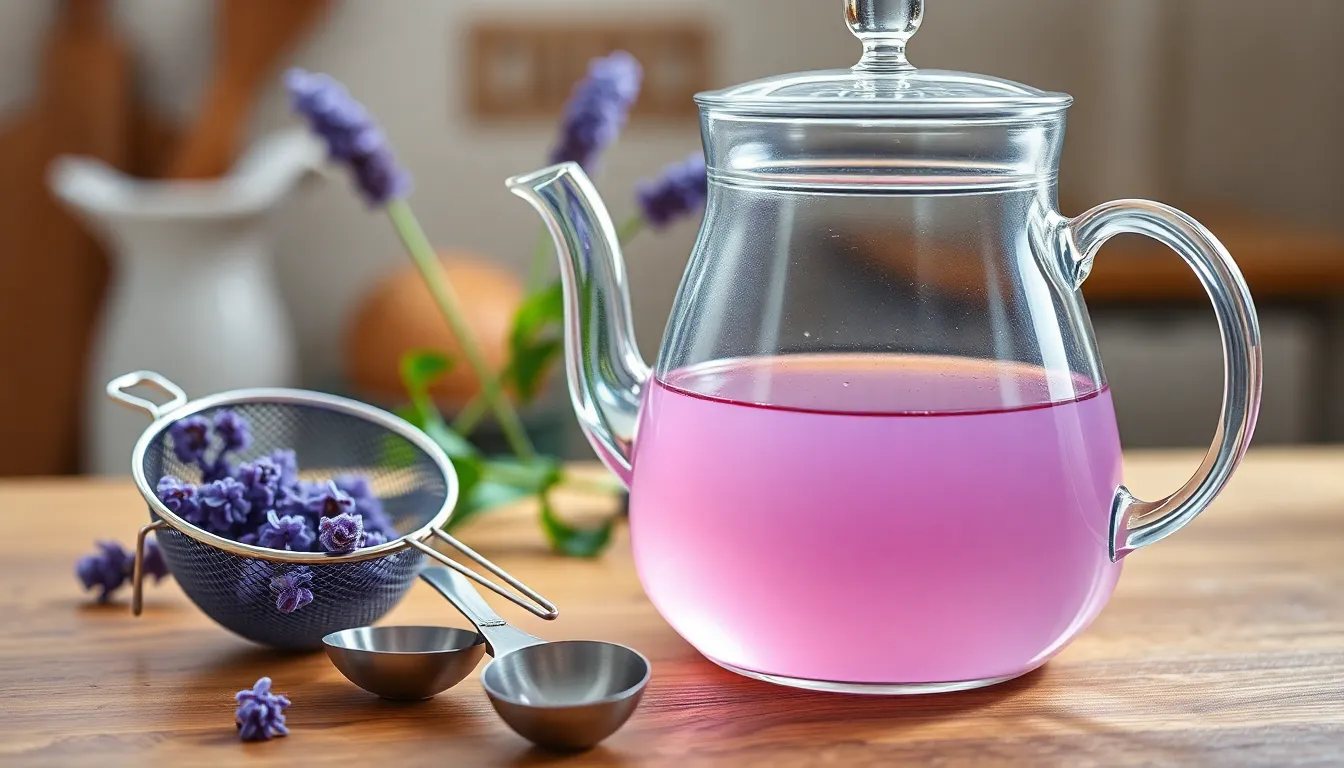
Brewing lavender tea requires minimal equipment to extract the maximum therapeutic benefits from the Lavandula angustifolia buds. We recommend gathering the following essential items before beginning the brewing process.
Teapot or Tea Infuser
A quality teapot with a built-in strainer serves as our primary brewing vessel. Glass or ceramic teapots work best since they won’t absorb the lavender’s essential oils or alter the delicate floral flavor. Tea infusers or tea balls provide an excellent alternative for single-cup brewing when preparing smaller quantities.
Fine Mesh Strainer
We need a fine mesh strainer to filter out the lavender buds completely. This equipment ensures our finished tea remains smooth and free from plant material that could create bitterness or an unpleasant texture. Stainless steel strainers offer durability and easy cleaning.
Digital Thermometer
Temperature control proves crucial for optimal extraction of lavender’s beneficial compounds. We use a digital thermometer to heat water to the precise 200°F needed for maximum potency. This temperature range protects the delicate antioxidants and calming compounds while preventing over-extraction that leads to bitter flavors.
Measuring Spoons
Accurate measurement ensures consistent results and proper therapeutic dosing. We use measuring spoons to portion the recommended 2 tablespoons of dried lavender buds per 8-ounce serving. Consistent measurements help us achieve the perfect balance between flavor intensity and wellness benefits.
Timer
Steeping time directly impacts the tea’s strength and therapeutic properties. We employ a timer to monitor the 5-7 minute steeping period needed to extract lavender’s stress-reducing and sleep-promoting compounds. Proper timing prevents over-steeping which can diminish the tea’s calming effects.
Heat-Resistant Cups or Mugs
Quality serving vessels enhance the overall lavender tea experience. We choose heat-resistant glass or ceramic cups that showcase the tea’s beautiful pale purple color while maintaining optimal temperature. These materials preserve the aromatic qualities that contribute to lavender tea’s anxiety-reducing benefits through aromatherapy.
Instructions

We’ll guide you through the simple process of brewing the perfect cup of lavender tea to maximize its therapeutic benefits. These straightforward steps ensure optimal extraction of the calming compounds that make lavender tea so effective.
Prep
We begin by measuring 1 teaspoon of dried lavender buds per 8 oz of water for the ideal strength and flavor balance. Our equipment should be ready with the teapot or infuser clean and the fine mesh strainer positioned nearby for easy filtering.
Heat your filtered water to 200°F using a digital thermometer for precision. Boiling water can destroy the delicate essential oils and create a bitter taste that masks lavender’s naturally sweet floral notes.
Place the measured lavender buds into your teapot or tea infuser. The organic Lavandula angustifolia buds will release their therapeutic compounds most effectively when properly prepared this way.
Steep
We pour the heated water over the lavender buds and start our timer immediately. The steeping process should last 5-7 minutes to extract the maximum beneficial compounds without creating an overly strong flavor.
Cover your teapot during steeping to prevent the essential oils from escaping through steam. These oils contain the primary therapeutic properties that provide lavender tea’s calming and anti-inflammatory benefits.
Watch for the water to develop a light golden color with a fragrant aroma that indicates proper extraction. The longer steeping time allows the antioxidants and calming compounds to fully infuse into the water.
Strain and Serve
We remove the lavender buds completely using our fine mesh strainer to ensure a smooth drinking experience. The strained liquid should appear clear and golden with no floating particles.
Pour the finished tea into heat-resistant cups or mugs while still warm to preserve the aromatherapy benefits. The steam carries essential oils that contribute to lavender tea’s stress-reducing properties.
Add optional honey or fresh lemon to taste if desired. These natural additions complement lavender’s therapeutic effects while improving the overall flavor profile without masking the delicate floral notes.
How to Make Lavender Tea Blends

Creating lavender tea blends amplifies the therapeutic benefits while introducing complementary flavors that enhance your wellness routine. We recommend these carefully crafted combinations to maximize both taste and health advantages.
Lavender Chamomile Tea
This powerful sleep-promoting blend combines two of nature’s most effective relaxation herbs for enhanced rest quality.
Ingredients:
- 1 teaspoon dried lavender buds
- 1 teaspoon dried chamomile flowers
- 1 cup boiling water
- Raw honey (optional)
Instructions:
Measure equal parts of lavender buds and chamomile flowers into your tea infuser. Pour 200°F water over the herb mixture and cover the teapot immediately to preserve essential oils. Steep the blend for 5-7 minutes to extract maximum therapeutic compounds from both herbs. Strain the liquid through a fine mesh strainer to remove all plant material. Add honey if desired for natural sweetness that complements the floral notes. We suggest drinking this blend 30 minutes before bedtime to experience the combined calming effects that promote deeper sleep phases.
Lavender Lemon Balm Tea
This refreshing combination delivers anxiety relief while providing an uplifting citrus aroma that soothes both mind and spirit.
Ingredients:
- 1 teaspoon dried lavender buds
- 1 teaspoon dried lemon balm leaves
- 1 cup boiling water
- Fresh lemon slice (optional)
Instructions:
Combine lavender buds with lemon balm leaves in your brewing vessel for optimal flavor extraction. Heat water to 200°F and pour over the herb mixture while ensuring complete saturation. Cover and steep for 5-7 minutes to allow the complementary compounds to merge effectively. Strain thoroughly to achieve a clear golden liquid free from herb particles. Garnish with a fresh lemon slice to enhance the citrus notes naturally present in lemon balm. This blend works exceptionally well as an afternoon stress reliever or evening wind-down beverage.
Lavender Mint Tea
This invigorating blend merges lavender’s calming properties with mint’s digestive benefits for a refreshing wellness experience.
Ingredients:
- 1 teaspoon dried lavender buds
- 1 teaspoon dried peppermint leaves
- 1 cup boiling water
- Fresh mint sprig (optional)
Instructions:
Mix lavender buds with peppermint leaves in your tea infuser to create this balanced therapeutic blend. Pour 200°F water over the herbs and cover immediately to capture the volatile oils from both plants. Allow the mixture to steep for 5-7 minutes to develop the full flavor profile and therapeutic benefits. Strain carefully to remove all herb residue and achieve a smooth drinking experience. Garnish with a fresh mint sprig for enhanced aroma and visual appeal. We recommend this blend after meals to support digestion while providing gentle relaxation throughout your digestive system.
Serving Suggestions
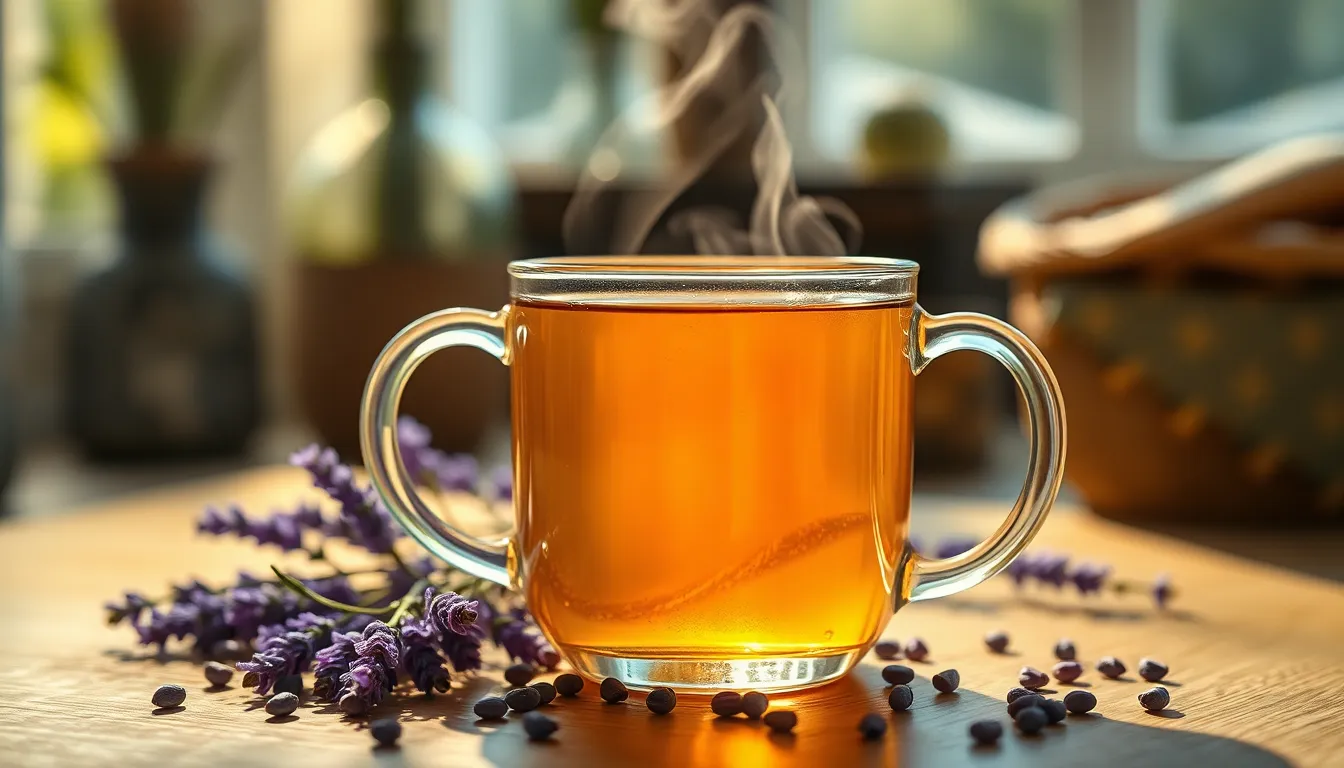
We recommend serving lavender tea during exact times of day to maximize its therapeutic benefits. Evening consumption proves most effective for sleep enhancement and relaxation, as the calming compounds work best when your body naturally prepares for rest.
Optimal Timing for Maximum Benefits
Research shows that lavender tea delivers the strongest results when consumed 30-60 minutes before bedtime. This timing allows the calming properties to take effect as your cortisol levels naturally decrease in the evening. For anxiety relief throughout the day, we suggest sipping lavender tea during afternoon stress peaks or before challenging situations.
Temperature and Presentation
We always serve lavender tea hot to release the maximum amount of therapeutic essential oils through steam inhalation. The aromatic compounds provide dual benefits when you inhale the steam while the tea cools to drinking temperature. Heat-resistant glass mugs showcase the tea’s beautiful pale golden color while maintaining optimal temperature longer than ceramic cups.
Improving the Aromatherapy Experience
To maximize the anxiety-reducing benefits documented in clinical studies, we recommend taking three deep breaths of the tea’s steam before your first sip. This practice combines the oral consumption benefits with proven aromatherapy effects. Position yourself in a quiet space where you can fully appreciate both the aroma and flavor without distractions.
Portion Guidelines and Frequency
| Serving Size | Lavender Buds | Water | Frequency |
|---|---|---|---|
| Single Cup | 1-2 teaspoons | 8 oz | 1-2 times daily |
| Therapeutic Dose | 2 teaspoons | 8 oz | Evening only |
| Maintenance | 1 teaspoon | 8 oz | As needed |
We suggest starting with one cup per day to assess your body’s response to lavender’s calming effects. Regular consumers often find that 1-2 cups daily provide consistent anxiety relief and improved sleep quality without causing drowsiness during daytime hours.
Complementary Serving Additions
Natural honey enhances lavender tea’s anti-inflammatory properties while adding gentle sweetness that doesn’t overpower the delicate floral notes. Fresh lemon juice provides vitamin C and brightens the flavor profile while supporting the tea’s immune-boosting compounds. We avoid artificial sweeteners that can interfere with lavender’s natural therapeutic effects.
Creating a Ritual
Establishing a consistent serving ritual amplifies lavender tea’s stress-reducing benefits through mindful consumption. We recommend setting aside 15-20 minutes for tea preparation and consumption without electronic devices or distractions. This intentional practice enhances the tea’s natural ability to reduce anxiety and promote relaxation through both physiological and psychological pathways.
Storage Tips
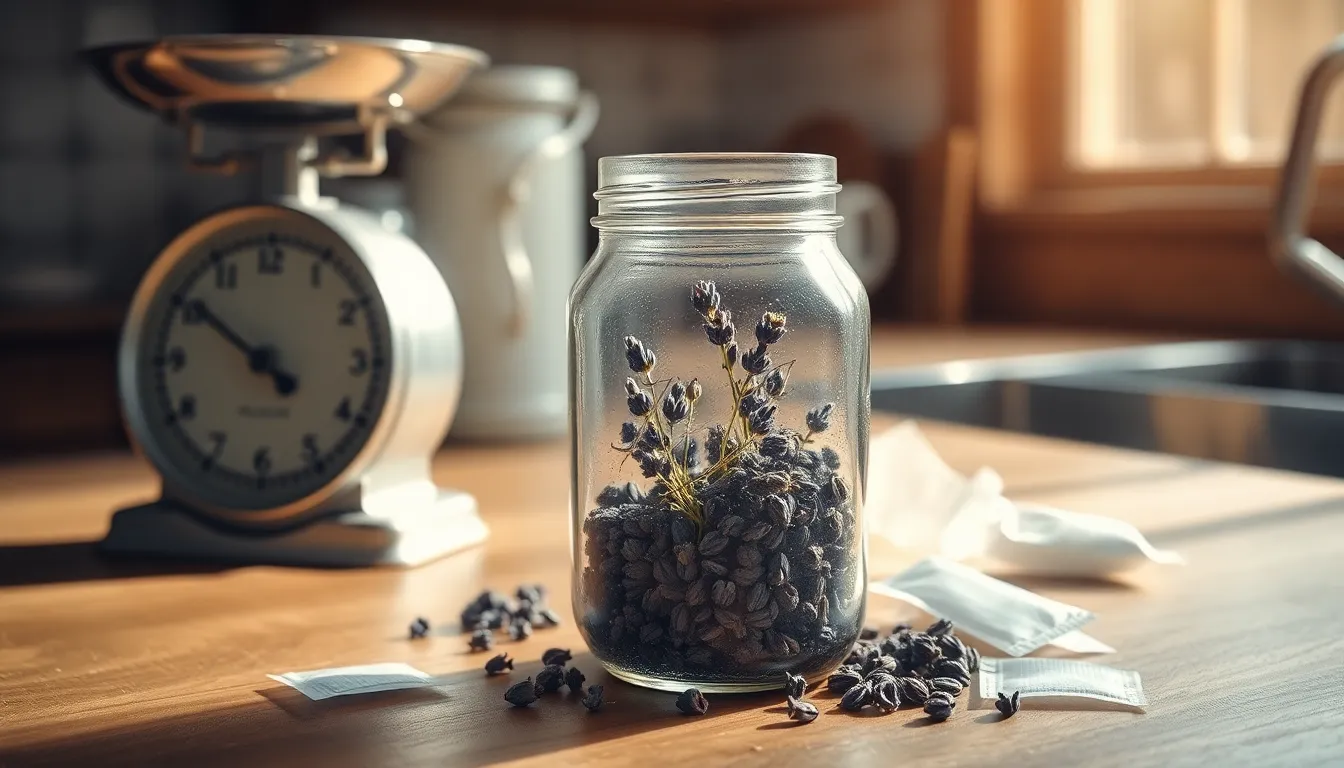
We know that proper storage techniques preserve the therapeutic properties and flavor of our lavender tea ingredients. Fresh dried lavender buds maintain their essential oils and potency when stored correctly.
Airtight Container Storage
We recommend transferring dried lavender buds into airtight glass jars or sealed containers immediately after purchase. Mason jars work exceptionally well for maintaining freshness. These containers prevent moisture exposure and protect the delicate essential oils that provide stress reduction and sleep enhancement benefits.
Optimal Storage Conditions
We store our lavender in cool, dark locations away from direct sunlight and heat sources. Pantries, cabinets, or dedicated spice storage areas maintain the ideal environment. Temperature fluctuations damage the compounds responsible for lavender’s antibacterial and antifungal properties.
Moisture Prevention
We ensure our storage area remains dry to prevent mold growth and preserve the flowers’ therapeutic qualities. Adding food-grade silica gel packets to storage containers provides extra moisture protection. Humid environments destroy the beneficial compounds that support mood enhancement and anxiety relief.
Labeling and Dating
We label each container with the storage date and lavender variety for quality tracking. English lavender maintains peak potency for 12-18 months when stored properly. French lavender retains its robust properties for similar timeframes under optimal conditions.
Avoiding Common Storage Mistakes
We never store lavender in plastic bags or containers that allow air exposure. Refrigerator storage creates condensation problems that damage the flowers. Direct sunlight exposure breaks down the essential oils responsible for headache relief and period pain reduction.
Pre-made Tea Blend Storage
We store our lavender chamomile, lavender lemon balm, and lavender mint blends using the same airtight principles. Each blend maintains its unique therapeutic profile when kept separate and properly sealed. Mixed blends require individual labeling to track their exact wellness benefits and shelf life.
Precautions and Side Effects
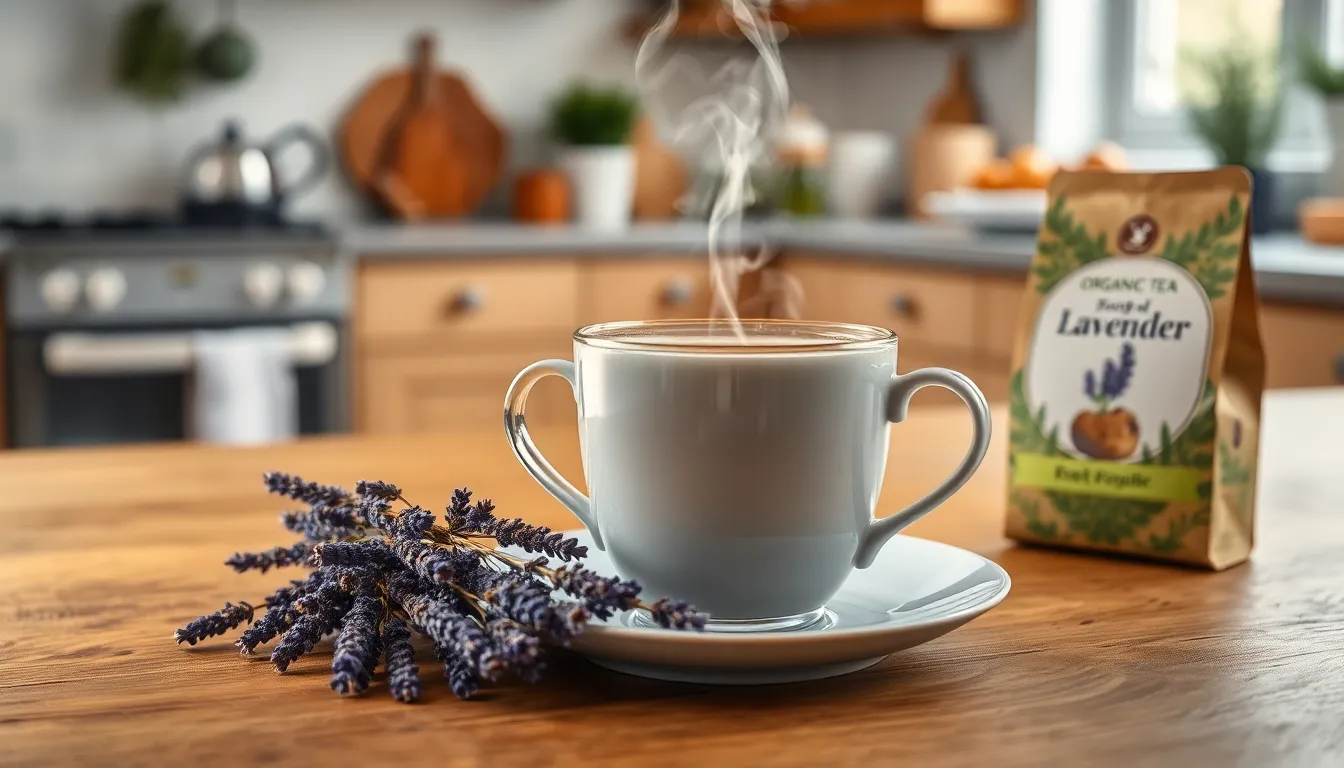
While lavender tea offers many wellness benefits, we must acknowledge important safety considerations before incorporating it into our daily routine. Research specifically on lavender tea remains limited, with most studies focusing on lavender extracts or oils rather than the brewed tea itself.
Allergic Reactions and Sensitivity
Some individuals may experience allergic reactions to lavender, particularly those with existing sensitivities to plants in the mint family. We recommend starting with small amounts to test your body’s response. Common allergic symptoms include skin irritation, nausea, or headaches that may occur after consumption.
Medication Interactions
Lavender products can interact with certain medications, especially those affecting the central nervous system. We strongly advise consulting with healthcare providers before drinking lavender tea if you take sedatives, antidepressants, or other medications that influence brain function. The calming compounds in lavender may amplify the effects of these medications.
Pregnancy and Breastfeeding Considerations
Pregnant or breastfeeding women should exercise caution with lavender tea consumption. We recommend consulting a healthcare provider before using lavender tea during these periods to avoid any potential risks to mother or baby. Limited research exists on lavender tea safety during pregnancy and lactation.
Dosage and Frequency Guidelines
| Recommended Usage | Frequency | Precautions |
|---|---|---|
| New users | 1 cup daily | Monitor for adverse reactions |
| Regular consumption | 2-3 cups daily | Avoid exceeding recommended amounts |
| Therapeutic use | Consult healthcare provider | Individual assessment needed |
Potential Side Effects
We’ve identified several possible side effects that may occur with lavender tea consumption. Nausea represents the most commonly reported adverse reaction, particularly when consuming strong concentrations. Headaches may develop in sensitive individuals, especially those prone to migraines or tension headaches.
Quality and Source Considerations
We emphasize purchasing lavender tea from reputable sources to ensure safety and quality. Low-quality or improperly processed lavender may contain contaminants or pesticides that could cause adverse reactions. Always verify that your lavender tea comes from organic, food-grade sources specifically intended for consumption.
Conclusion
We’ve explored the remarkable industry of lavender tea and its impressive array of wellness benefits. From promoting restful sleep to reducing anxiety and supporting digestive health this caffeine-free herbal infusion offers a natural approach to improving our daily well-being.
The key to maximizing lavender tea’s therapeutic potential lies in proper preparation and mindful consumption. By selecting high-quality organic lavender buds brewing at the correct temperature and establishing consistent tea rituals we can unlock the full spectrum of benefits this aromatic beverage provides.
Whether you’re seeking a calming evening ritual or exploring creative blends with complementary herbs lavender tea deserves a place in your wellness routine. Remember to start slowly consult with healthcare providers when necessary and store your lavender properly to maintain its potency.
With its gentle floral notes and proven therapeutic properties lavender tea offers us a simple yet powerful way to embrace natural wellness in our modern lives.
Frequently Asked Questions
What is lavender tea and how is it made?
Lavender tea is a caffeine-free herbal infusion made from dried flowers and buds of the Lavandula plant, primarily English lavender (Lavandula angustifolia). Unlike traditional teas, it’s prepared by steeping dried lavender buds in hot water. The flowers are harvested at peak bloom and carefully dried to preserve their therapeutic properties and aromatic compounds.
What are the main health benefits of drinking lavender tea?
Lavender tea offers multiple scientifically-backed benefits including improved sleep quality, reduced anxiety and stress, better digestive health, and anti-inflammatory properties. It helps increase deep slow-wave sleep, lowers cortisol levels, and supports cardiovascular health. The tea also provides skin health benefits through its antibacterial and antifungal properties.
Which type of lavender is best for making tea?
English Lavender (Lavandula angustifolia) is considered the gold standard for tea preparation due to its delicate flavor and optimal therapeutic compounds. French Lavender (Lavandula stoechas) offers a more robust flavor with stronger herbal properties. Always choose high-quality, organic dried lavender for the best flavor and health benefits.
How do you properly brew lavender tea?
Use 1 teaspoon of dried lavender buds per 8 oz of filtered water heated to 200°F. Steep for 5-7 minutes with the teapot covered to retain essential oils. Strain the tea to ensure a clear liquid, then add optional honey or lemon for enhanced flavor. This method maximizes therapeutic benefits while preventing bitterness.
When is the best time to drink lavender tea?
Lavender tea is most effective when consumed 30-60 minutes before bedtime for sleep enhancement. It can also be enjoyed during afternoon stress peaks for anxiety relief. Serving it hot releases therapeutic essential oils, and inhaling the steam before sipping enhances the aromatherapy experience.
Are there any safety concerns with lavender tea?
While generally safe, some individuals may experience allergic reactions, especially those sensitive to mint family plants. Pregnant or breastfeeding women should consult healthcare providers before consumption. Those taking central nervous system medications should also seek medical advice, as lavender may amplify their effects. Start with small amounts initially.
How should lavender tea ingredients be stored?
Store dried lavender buds in airtight glass containers in cool, dark locations away from direct sunlight and heat. Prevent moisture exposure to avoid mold growth. Properly stored English lavender maintains peak potency for 12-18 months. Label containers with storage dates and avoid using plastic bags or refrigeration for optimal preservation.
Can you create blends with lavender tea?
Yes, lavender tea blends wonderfully with other herbs to amplify therapeutic benefits. Popular combinations include Lavender Chamomile for sleep enhancement, Lavender Lemon Balm for anxiety relief, and Lavender Mint for digestive benefits. Each blend requires specific steeping times and temperatures to maximize both flavor and health advantages.

